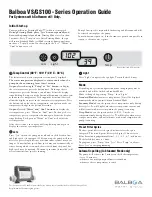
7
CAUTION
To prevent damage to the wiring, protect wiring from
sharp edges. Follow national electrical code and local
codes and ordinances. Do not route wires through re
-
movable access panels.
CAUTION
Conduit and fittings must be weather-tight to prevent
water entry into the building.
For unit protection, use a fuse or hacr circuit breaker that is
in excess of the circuit ampacity, but less than or equal to the
maximum overcurrent protection device. DO NOT EXCEED
THE MAXIMUM OVERCURRENT DEVICE SIZE SHOWN
ON UNIT DATA PLATE.
All line voltage connections must be made through
weatherproof fittings. All exterior power supply and ground
wiring must be in approved weatherproof conduit.
The main power supply wiring to the unit and low voltage
wiring to accessory controls must be done in accordance with
these instructions, the latest edition of the National Electrical
Code (ANSI/NFPA 70), and all local codes and ordinances.
The unit is factory wired for the voltage shown on the unit’s
data plate. Refer to model nomenclature in Appendix B for
voltage requirement for your unit.
NOTE: If supply voltage is 208V, lead on primary of
transformer(s) must be moved from the 230V to the 208V
tap. Refer to wiring diagram on unit for details.
Main power wiring should be sized for the minimum circuit
ampacity shown on the unit’s data plate. Size wires in accordance
with the ampacity tables in Article 310 of the National Electrical
Code. If long wires are required, it may be necessary to increase
the wire size to prevent excessive voltage drop. Wires should
be sized for a maximum of 3% voltage drop.
CAUTION
To avoid property damage or personal injury due to
fire, use only copper conductors.
CAUTION
Label all wires prior to disconnection when servic
-
ing controls. Wiring errors can cause improper and
dangerous operation. Verify proper operation after
servicing.
NOTE: A weather-tight disconnect switch, properly sized for the
unit total load, must be field or factory installed. An external field
supplied disconnect may be mounted on the exterior panel.
Ensure the data plate is not covered by the field-supplied
disconnect switch.
• Some disconnect switches are not fused. Protect the power
leads at the point of distribution in accordance with the
unit’s data plate.
• The unit must be electrically grounded in accordance
with local codes or, in the absence of local codes, with
the latest edition of the National Electrical Code (ANSI-
NFPA 70). A ground lug is provided for this purpose. Size
grounding conductor in accordance with Table 250-95 of
the National Electrical Code. Do not use the ground lug
for connecting a neutral conductor.
• Remove plug in panel located at the condenser end of
unit and route conduit to control box. Remove plug in
control box and connect power wiring to the contactor
closest to the entrance. If Single Point kit is used, refer
to Installation Instructions supplied with kit.
LOW VOLTAGE
BLOCK
MAIN POWER
LOW VOLTAGE
ENTRANCE
POWER THRU
THE CURB
CONTROL BOX
LOW VOLTAGE/THERMOSTAT CONNECTIONS
NOTE:
Some models may vary from illustration.
Models with electric heat are equipped with a
power block for field connections.
GROUND
LUG
CONTROL BOX CONNECTIONS
NOTE: Depending on the options installed, the location of the
components may vary in some models.
WARNING
Failure of unit due to operation on improper line voltage
or with excessive phase unbalance constitutes product
abuse is not covered by the warranty and may cause severe
damage to the unit electrical components.
Areas Without Convenience Outlet
It is recommended that an independent 115V power source
be brought to the vicinity of the roof top unit for portable lights
and tools used by the service mechanic.
NOTE: Refer to local codes for requirements. These outlets
can also be factory installed.
Units installed on Roof Tops
Main power and low voltage wiring may enter the unit through
the condenser end or through the roof curb. Install conduit
connectors at the desired entrance locations. External
Summary of Contents for DTC Series
Page 18: ...18 APPENDIX B ELECTRICAL DATA ...








































